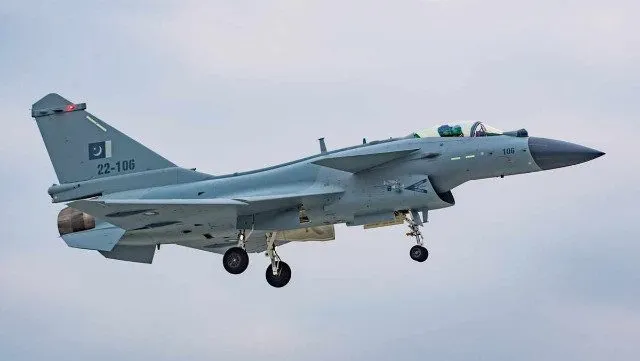Battle of the Invisible Kills

Contested as a four-day battle, conflict, or war, South Asia saw a seismic shift in the doctrine of modern air combat. Around 40 PAF fighter jets roared like predators against the approximately 70 of the IAF. There were no close combats, no top gun theatrics, only invisible ghostly missiles screaming across vast beyond-visual distances. At the centre of the aerial combat, the Chinese-built PL-15 BVR missile reigned supreme, turning distance into dominance and striking the prey before it knew it was being hunted. Not attrition but annihilation. The IAF’s pride—and the reputation of its French-built jets—burned away in the wake of a perfectly orchestrated strategy and technology.
What did India want to achieve by putting the lives of 1.5 billion at stake? The Indian objectives can easily be analysed through the prism of Hindutva doctrine—portray Pakistan as the epicentre of terrorism and isolate it diplomatically, discredit Pakistan’s military and assert regional hegemony, and systematically weaken Pakistan’s economy. Pakistan’s objectives are equally clear: safeguarding its sovereignty and territorial integrity while inflicting sufficient damage on Indian military assets to restore conventional deterrence, keeping the strategic deterrence intact.
The central question stemming from 2019’s Operation Bandar and 2025’s Operation Sindoor is why India repeatedly fails to anticipate Pakistan’s response and instead seems surprised. Did Indian policymakers incorrectly assume that Pakistan, facing internal political and economic challenges, would avoid a direct military confrontation? It is equally important to identify if Indians carried out these operations with the tacit approval of one or more major powers, and if so, then what kind of assurances did they get from them? What happened between US Deputy President JD Vance’s statement, “fundamentally none of our business,” to President Trump’s announcement of “long night of talks mediated by the United States,” and a “full and immediate ceasefire.” Were the reported Israeli boots on Indian soil just about defence contracts and advisory, or was this entire adventure linked to shaping a much broader geopolitical script on the future Israel-Iran confrontation?
Why the IAF has repeatedly failed to outperform the PAF is a question that should command Prime Minister Modi’s attention. On the bigger canvas, one plausible reason lies in how the Indian political hierarchy asserts itself on the military establishment and how, at times, it seems to veto their opinions. This assessment is amply supported by the demeanour of the Indian military leadership in joint meetings and how senior military leadership was reportedly shuffled during this contingency. Worst still is that those in India tasked with the national defence at the top think a fighter aircraft can easily be obscured behind a cloud. Another key reason for the IAF’s underperformance may be its departure from Colonel John Warden’s principle that “Air power must be used as a tool of independent strategy.” Under the Chief of Defence Staff framework, the air force’s planning autonomy and strategic flexibility are often compromised. While such frameworks offer coherence, they risk subordinating air strategy to broader land-centric priorities. At the tactical level, the PAF’s proactive defence and timely CAP positioning likely surprised the IAF, reversing attacker-defender roles. The 6-0 outcome raises questions on the IAF’s ability to undertake multi-domain operations effectively. There seemed to be critical lapses in situational awareness—misjudging the PL-15’s kill envelope and sub-optimal anti-BVR manoeuvres. Amidst all the shortcomings in the air-to-air domain, the IAF deserve the credit for striking their planned targets on the ground. After all, it is believed that “No matter how effective an air defence may be, some raiders will always sneak through”.
Despite certain limitations of resources, the PAF’s edge stems from centralised command, decentralised execution, rapid kill-chain, first-shot capability, advanced multi-role radars, AWACS, C² centres, net-centricity, and cyber-electronic dominance. Intangibles like training, aggressive mindsets, fearless initiatives, morale, motivation, and teamwork further elevate its edge. While pilots and engineers deserve rightful praise, the performance of the silent sentinels of air defence — those who detect, classify threats, direct tactical response, and support pilots throughout the aerial combat is equally commendable. Most importantly, the PAF leadership made a difference through their clear strategic vision, employment strategy of unleashing airpower with the offensiveness it demanded and fighting the odds with unwavering courage.
Pakistan must now ask if its conventional deterrence has been restored and how long the uneasy calm will hold. If the Indian narrative shifts from ‘If only we had Rafales’ to ‘If only we had F-35’, then there is a good chance of fragile peace for the next 4-5 years before history strikes again. If not, Pakistan must remain on high alert for the next 3-4 months and quickly take note of its weapon arsenal. The focus should be on fostering the defence against drone war and supersonic cruise missiles, alongside enhancing the number of PL-15 missiles. The flipside of this entire episode is that a dangerous new norm has been set, which witnessed enhanced space under nuclear overhang; the space to hit across international borders, use of supersonic missiles, airfield strikes, and armed drones hovering over the civil population. Any new (mis)adventure will likely witness a higher notch of fire and fury.
Do the people of the subcontinent deserve to live under the shadow of fear and hunger, paying the price for wars they never chose? Is it fair for India to stop the water of Pakistan, and assume that Pakistanis will happily die of thirst? How is it wise that one tragic act of terror ends up claiming hundreds more innocent lives, without even attempting a mature, humane solution? Is it not high time to say no to war and yes to dialogue, with open hearts and sealed hatred?


